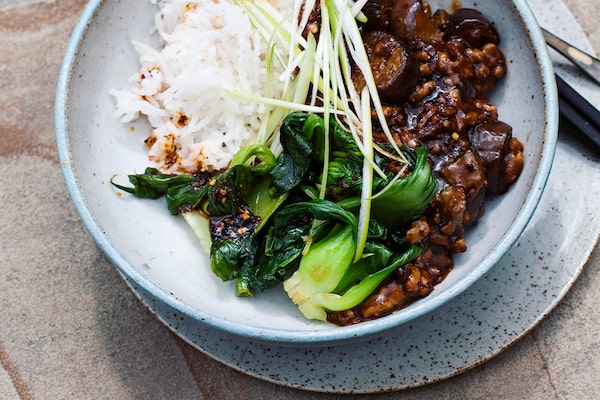
Ma Po Doufu-style eggplantTara O'Brady
Most days, I work from home. As much as I’d like to say I eat breakfast with my children and husband, I usually only have a coffee or tea in hand as they tuck in.
The truth is, I’m usually not hungry when they are. So, by choice, I wait. My meal comes later, at about 9:30 or 10. It’s invariably a brunch-ish production of something savoury made just for me, eaten on my own, but not by my lonesome.
A meal for one has often been viewed as a result of absence, rather than as individualism. Besides preference, there is also a practical need for meals for one. No matter the number sharing a home, there can be dietary restrictions or specific meal plans; lunches for school and work; and, as family meals are often split between members eating at various times, there is increasing occasion to eat on one’s own.
This reality brings unexpected boons. In a time mired in concerns of excess and food waste, purchasing, preparing, and enjoying a single, discrete portion without leftovers is an act of conservation. Cooking for one requires thought about appetite, quantity and need.
It is also a practice of creativity. I always save whatever spoonfuls of rice that might remain from dinner, or the few roasted vegetables left in the serving dish. The next day, with a fry up of both, a handful of greens, a quick herb and chili oil, and an egg, I have my meal. It is impromptu cooking that keeps me on my toes, as I’m challenged with what’s on hand.
What’s more, certain foods are arguably better when made in small quantities. There is a greater joy in frying chicken for one than it is for a crowd, as much as convention makes us want to believe the latter. There’s no need for a vat of oil, no endless frying, or worrying about keeping the first pieces as the last are still in their bath. Chicken goes in, chicken comes out, you eat. The end.
Anita Lo, chef and restaurateur, tackled the topic in her book Solo: A Modern Cookbook for a Party of One. She approaches cooking and dining for one as “one of the most blissful and empowering experiences you can have,” and views the ritual as the chance to extend hospitality to ourselves.
Cookbook author, television host and actress Tiffani Thiessen is the primary cook in her family and sometimes feels the pressure to provide. “Being a mom of two young kids and being the only one that cooks in the house, all eyes are on me for the daily question of ‘What are we eating today, Mom?’ Don’t get me wrong, It is a position I get a lot of joy out of,” she says. “But, some mornings and some nights, I secretly yearn for a quiet meal of my own."
Theissen sees these meals as emotional self-care. "Even if it is only a few moments, it is something I am doing for me … to think of my body and all the amazing things it has done and continues to do.”
Cooking for one means there is only one appetite to appease, on your own schedule. It is a release from the obligation to please anyone else but yourself.
Eggplant Ma Po Doufu Style
Ingredients (Serves 1)
- 1 tablespoon cornstarch
- 1/3 cup sodium-free chicken stock or water
- 1 Japanese eggplant, halved lengthwise, then cut into 2/3-inch thick half moons (approximately 6 ounces)
- Salt
- 3 tablespoons oil
- 2 ounces ground pork
- 1/2 clove garlic, finely chopped
- 1/2 teaspoon ginger, grated
- 1 tablespoon Lao Gan Ma chili sauce
- 2 tablespoons soy sauce
- 1 tablespoon scallion greens, sliced
- Plain cooked rice, for serving
In a small bowl, mix the cornstarch with the chicken stock or water and set aside.
Sprinkle the cut eggplant with the salt and allow to sit while you prepare the other ingredients, then blot dry with a clean paper towel. Heat a 10-inch sauté pan on high (a nonstick one would be good for this, but is not essential), and add the oil. When just smoking, add the eggplant and shake to make one layer. Turn the heat to medium high and cook until lightly browned, then stir. Add the ground pork, crumbling as you go, then add the garlic and ginger and stir. Add the Lao Gan Ma and the soy sauce and stir again. Then add the cornstarch slurry and cook for 2 minutes, stirring, until it is translucent and thick. Garnish with the scallions and serve over plain cooked rice.
Excerpted from Solo: A Modern Cookbook For A Party of One by Anita Lo. Copyright © 2018 by Anita Lo. Illustrations Copyright © 2018 Julia Rothman. Published by Alfred A. Knopf Canada, a division of Penguin Random House Canada Limited. Reproduced by arrangement with the publisher. All rights reserved.
Live your best. We have a daily Life & Arts newsletter, providing you with our latest stories on health, travel, food and culture. Sign up today.